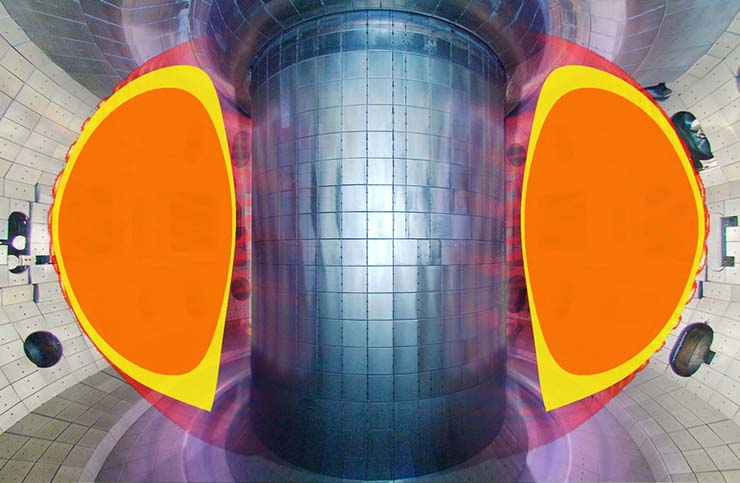
Super-H Mode, as the researchers dub the approach, allows tokamaks to achieve higher fusion performance than previously possible. In recent experiments operating in and near the Super H-mode regime, researchers have achieved record-breaking values of fusion gain for a device of DIII-D’s size. Fusion gain is the ratio of fusion power generated to heating power.
“Our latest experiments have shown very encouraging results, so it’s becoming clear there is significant potential to move practical fusion energy a step closer to reality,” said Phil Snyder, director of the Theory and Computational Science Group at GA, the San Diego-based contractor that operates DIII-D as a national user facility for the U.S. Department of Energy. “It’s very exciting from both a scientific and a fusion energy perspective.”
Professor Steven Cowley, director of the Princeton Plasma Physics Laboratory, said the new discovery is highly important for the fusion energy community.
“Super-H Mode promises to reduce the cost and scale of future fusion reactors, thereby bringing the realization of fusion power closer,” said Cowley, who was not involved in the research. “It couldn’t be more significant.”
A tokamak is a doughnut-shaped device with strong magnetic fields that confine matter at temperatures exceeding 100 million degrees. Inside the tokamak, matter transitions to a plasma state where electrons are stripped from their nuclei. The resulting electrically charged plasma can be shaped and controlled by the magnetic fields. Within a sufficiently hot plasma, atoms collide and fuse together, producing fusion energy in a manner similar to the sun. (See Fusion Energy 101 explainer below for more detail on how fusion works.)
Scientists have been working to develop more effective methods for confining plasmas at the temperatures and pressures necessary for cost-effective fusion energy. Snyder and his colleagues at GA – along with Professor Howard Wilson and his research group at the University of York and Culham Centre for Fusion Energy (UK) – developed the theoretical model that predicted Super H-Mode. The findings developed by the model were confirmed by a series of record-breaking experiments on DIII-D and the Alcator C-Mod tokamak at MIT. The work was conducted by a multi-institutional team from GA, MIT, Princeton, LMU Munich, Lawrence Livermore National Laboratory, University of Wisconsin, College of William and Mary, and the University of California, Irvine.
Super-H Mode works by increasing temperature and pressure in the outer region of the plasma, called the pedestal. The experiments showed – as the theory predicted – that proper tuning of the plasma cross-sectional shape and density leads to pedestal temperatures and pressures that are more than twice as high as those of typical pedestals.
Because plasma conditions in the core – where fusion takes place – are dependent on conditions at the edge, Super-H Mode enables as much as a four-fold increase in fusion performance.
“When our calculations first predicted the existence of the Super-H regime, we thought it might just be a theoretical curiosity,” Snyder said. “But we soon realized that with appropriate control, it could be realized experimentally.”
Though more research needs to be conducted, the advantages offered by Super-H Mode mean commercial fusion reactors could be substantially smaller and less expensive than once thought.
“Fusion energy research historically advances with steady and marked improvements over time,” said David Hill, director of DIII-D. “It is not often you see a significant leap in results like we have seen with Super-H Mode. This discovery has significant ramifications for future fusion energy plants, and we’re excited to see how far it will carry the field forward.”








